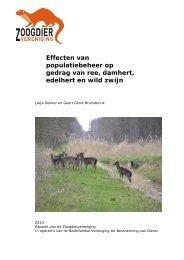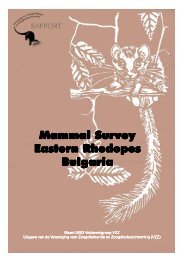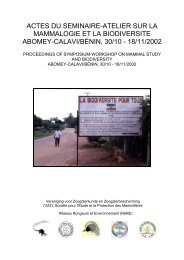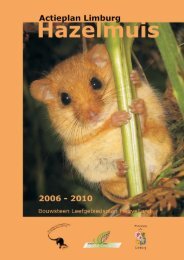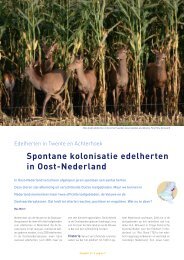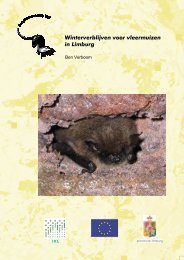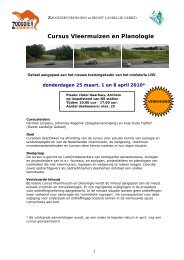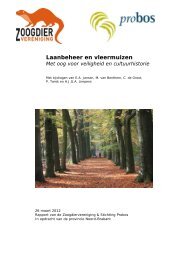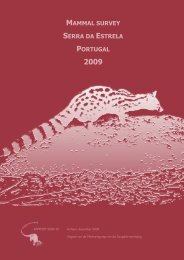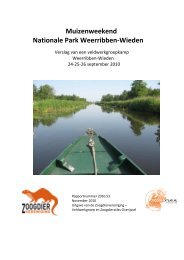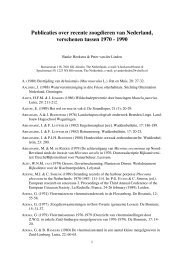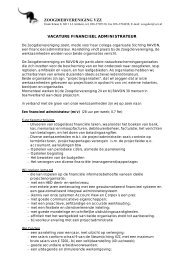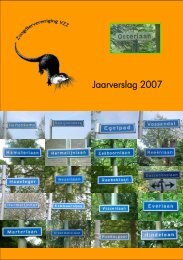The history of urban foxes in Aarhus and Copenhagen, Denmark
The history of urban foxes in Aarhus and Copenhagen, Denmark
The history of urban foxes in Aarhus and Copenhagen, Denmark
Create successful ePaper yourself
Turn your PDF publications into a flip-book with our unique Google optimized e-Paper software.
<strong>The</strong> <strong>history</strong> <strong>of</strong> <strong>urban</strong> <strong>foxes</strong> <strong>in</strong> <strong>Aarhus</strong> <strong>and</strong> <strong>Copenhagen</strong>, <strong>Denmark</strong>Sussie Pagh*Natural History Museum <strong>Aarhus</strong>, Wilhelm Meyers Allé 210, Universitetsparken, DK-8000 <strong>Aarhus</strong> C., <strong>Denmark</strong>,e-mail: sussie@nathist.dkAbstract: Literature testifies to the presence <strong>of</strong> red <strong>foxes</strong> (Vulpes vulpes) <strong>in</strong> <strong>Copenhagen</strong> as early as the time<strong>of</strong> the Slesvig War <strong>in</strong> 1848-1850, <strong>and</strong> they became numerous from the middle <strong>of</strong> the 1960s onwards. In <strong>Aarhus</strong>red <strong>foxes</strong> have only become numerous with<strong>in</strong> the last 15 years. In both cities <strong>foxes</strong> seem to have colonized thecities at times when the ma<strong>in</strong> cause <strong>of</strong> death around the city border was not hunt<strong>in</strong>g, but when there were protectedgreen areas established close to the city border <strong>and</strong>/or dur<strong>in</strong>g periods when persecution by man was low.Keywords: <strong>urban</strong> ecology, red fox, colonization, city.IntroductionUrban red <strong>foxes</strong> (Vulpes vulpes) are well-known<strong>in</strong> British cities (e.g. Macdonald & Newdick1982, Harris & Rayner 1986) <strong>and</strong> have beenpresent <strong>in</strong> London s<strong>in</strong>ce the 1930s (Teagle1967). Initially this was thought to be a uniquelyBritish phenomenon (Harris 1977, Macdonald& Newdick 1982). However, dur<strong>in</strong>g the past25-30 years <strong>foxes</strong> have been reported <strong>in</strong> severalEuropean cities <strong>and</strong> suburbs e.g. Paris, France(Brosset 1975), Stockholm, Sweden (Page1981), Oslo, Norway (Christensen 1985) <strong>and</strong>Stuttgart, Germany (Gloor et al. 2001). S<strong>in</strong>ce1985 <strong>foxes</strong> have become widespread <strong>in</strong> the cities<strong>of</strong> Switzerl<strong>and</strong> e.g. Zurich <strong>and</strong> Geneva (Gloor etal. 2001). In <strong>Denmark</strong> <strong>foxes</strong> have been observed<strong>in</strong> several cities, <strong>and</strong> they have been studied <strong>in</strong><strong>Aarhus</strong> <strong>and</strong> <strong>Copenhagen</strong> (Nielsen 1989, Nielsen1990, Simonsen et al. 2003).<strong>The</strong> <strong>in</strong>vasion times <strong>of</strong> <strong>foxes</strong> <strong>in</strong> differentEuropean cities are not synchronous. As aresult, there are several theories <strong>and</strong> hypothesesabout how, why <strong>and</strong> when <strong>foxes</strong> colonize <strong>urban</strong>areas. Gloor et al. (2001) propose two ma<strong>in</strong>hypothetical explanations for the presence <strong>of</strong><strong>urban</strong> <strong>foxes</strong>: the population pressure hypothesis(PPH), <strong>and</strong> the <strong>urban</strong> isl<strong>and</strong> hypothesis (UIH).<strong>The</strong> PPH assumes these <strong>foxes</strong> to be <strong>in</strong>trudersfrom adjacent rural areas, which <strong>in</strong>vade humansettlements because <strong>of</strong> high population density<strong>in</strong> rural areas. Hence the PPH assumes that thesize <strong>of</strong> the <strong>urban</strong> fox population size is closelycorrelated to that <strong>of</strong> the fox population <strong>in</strong>adjacent rural areas, <strong>and</strong> as such does not expectany genetic isolation between the <strong>urban</strong> <strong>foxes</strong> <strong>and</strong>the population <strong>in</strong> the rural surround<strong>in</strong>gs. Urbanareas provide suboptimal habitats for <strong>foxes</strong>. <strong>The</strong>UIH postulates that <strong>urban</strong> <strong>foxes</strong> have adapted tospecific <strong>urban</strong> conditions, such as a high density<strong>of</strong> human population, scaveng<strong>in</strong>g food items <strong>and</strong>f<strong>in</strong>d<strong>in</strong>g special hid<strong>in</strong>g places. It argues that <strong>foxes</strong>live <strong>in</strong> <strong>urban</strong> areas, not out <strong>of</strong> necessity due tolack <strong>of</strong> breed<strong>in</strong>g space or food shortages <strong>in</strong> thesurround<strong>in</strong>g areas, but because they f<strong>in</strong>d sufficientresources <strong>and</strong> conditions to breed <strong>and</strong> spreadwith<strong>in</strong> human settlements. <strong>The</strong> UIH expects nocorrelation between fox populations <strong>in</strong> the <strong>urban</strong><strong>and</strong> surround<strong>in</strong>g rural areas, <strong>and</strong> implies geneticisolation over time (Gloor. et al. 2001).© 2008 Verenig<strong>in</strong>g voor Zoogdierkunde en Zoogdierbescherm<strong>in</strong>g.Lutra articles also on the <strong>in</strong>ternet:http://www.vzz.nl* Formerly S.M. Nielsen.Pagh / Lutra 2008 51 (1): 51-55 51
This paper describes the <strong>history</strong> <strong>of</strong> <strong>foxes</strong> <strong>in</strong>vad<strong>in</strong>gthe cities <strong>of</strong> <strong>Copenhagen</strong> (1.8 million citizens)<strong>and</strong> <strong>Aarhus</strong> (293,000 citizens), <strong>and</strong> discussthis <strong>and</strong> its tim<strong>in</strong>g <strong>in</strong> relation to the two theoriesput forward by Gloor et al. (2001).<strong>The</strong> <strong>history</strong> <strong>of</strong> <strong>urban</strong> <strong>foxes</strong> <strong>in</strong><strong>Copenhagen</strong>Literature testifies to the presence <strong>of</strong> <strong>foxes</strong> <strong>in</strong> <strong>Copenhagen</strong>already as early as the time <strong>of</strong> the SlesvigWar <strong>in</strong> 1848-1850, where <strong>foxes</strong> denned <strong>in</strong> theembankments glacis <strong>of</strong> the ramparts <strong>of</strong> <strong>Copenhagen</strong>(Tauber 1878). Accord<strong>in</strong>g to Tauber (1878)the glacis were fertilized by refuses from the city<strong>and</strong> police <strong>and</strong> soldiers kept the ramparts undersurveillance, both acts result<strong>in</strong>g <strong>in</strong> a rich mammalfauna. Foxes were also seen at the MarblePlace <strong>in</strong> the centre <strong>of</strong> <strong>Copenhagen</strong> at that time(Tauber 1878). Tauber (1878) assumed that themen were then occupied with combat, <strong>and</strong> thereforehad less time for hunt<strong>in</strong>g, so the fox population,together with other wildlife populations,<strong>in</strong>creased noticeably both around <strong>and</strong> <strong>in</strong>side thecity borders. After the war, when hunt<strong>in</strong>g wastaken up aga<strong>in</strong>, the number <strong>of</strong> <strong>foxes</strong> outside thecity decreased, but was ma<strong>in</strong>ta<strong>in</strong>ed <strong>in</strong>side theramparts (Tauber 1878). In 1860 <strong>foxes</strong> were sonumerous <strong>in</strong> Frederiksberg Garden that they hadalmost underm<strong>in</strong>ed the Ch<strong>in</strong>ese Pavilion (Hvass1940).By the end <strong>of</strong> the 19th century <strong>foxes</strong> becamerare with<strong>in</strong> the city <strong>of</strong> <strong>Copenhagen</strong>, althoughthey were still present (Tauber 1878). At the beg<strong>in</strong>n<strong>in</strong>g<strong>of</strong> the 20th century <strong>foxes</strong> were present<strong>in</strong> the outskirts <strong>of</strong> <strong>Copenhagen</strong>, especially nearwaste deposits (Degerbøl 1930, Holten 1935,Hvass 1940). In two numbers <strong>of</strong> hunt<strong>in</strong>g magaz<strong>in</strong>esfrom 1953 <strong>foxes</strong>, seen <strong>in</strong> different residentialareas <strong>of</strong> <strong>Copenhagen</strong>, are mentioned <strong>in</strong> shortcommunications e.g. fox cubs play<strong>in</strong>g at broaddaylight by the road <strong>and</strong> <strong>foxes</strong> enter<strong>in</strong>g gardensto steel fowl <strong>in</strong> chicken runs (Anonymous 1953a,Anonymous 1953b). In the 1950s <strong>foxes</strong> are alsoknown to have denned under a workmen’s hutdur<strong>in</strong>g the construction <strong>of</strong> the new ZoologicalMuseum <strong>of</strong> <strong>Copenhagen</strong> <strong>and</strong> under the steps<strong>of</strong> the School <strong>of</strong> Dentistry (B. Jensen, personalcommunication, zoology student <strong>in</strong> <strong>Copenhagen</strong><strong>in</strong> 1950).In 1963 Hvass wrote that <strong>foxes</strong> had becomenumerous <strong>and</strong> he presented several records <strong>of</strong>fox sight<strong>in</strong>gs <strong>in</strong> built-up areas where the <strong>foxes</strong>showed little or no reaction to human activity(Hvass 1963). <strong>The</strong> presence <strong>of</strong> <strong>foxes</strong> <strong>in</strong> thesuburbs <strong>of</strong> <strong>Copenhagen</strong> is also mentioned <strong>in</strong>literature from the 1970s (Jensen 1972). From1980 onwards the <strong>foxes</strong> <strong>of</strong> <strong>Copenhagen</strong> received<strong>in</strong>creas<strong>in</strong>g media attention, with articles aboutfearless <strong>foxes</strong> enter<strong>in</strong>g gardens <strong>and</strong> houses.In 2005 local authorities received more than300 compla<strong>in</strong>ts about <strong>foxes</strong> be<strong>in</strong>g a nuisance topeople <strong>in</strong> the built-up area <strong>of</strong> <strong>Copenhagen</strong>, accord<strong>in</strong>gto the Danish Forest <strong>and</strong> Nature Agency,M<strong>in</strong>istry <strong>of</strong> Environment. A study, carried outbetween 1997 <strong>and</strong> 1999, found genetic <strong>and</strong> morphometricaldifferentiation between the <strong>foxes</strong>from <strong>Copenhagen</strong> <strong>and</strong> those from the rest <strong>of</strong>Zeal<strong>and</strong> (Simonsen et al. 2003).<strong>The</strong> rise <strong>of</strong> <strong>urban</strong> <strong>foxes</strong> <strong>in</strong> the city <strong>of</strong><strong>Aarhus</strong><strong>The</strong>re are no records about the presence <strong>of</strong><strong>foxes</strong> <strong>in</strong> the city <strong>of</strong> <strong>Aarhus</strong> before 1986. <strong>The</strong>first survey <strong>of</strong> <strong>foxes</strong> <strong>in</strong> the city <strong>of</strong> <strong>Aarhus</strong> wascarried out between 1986 <strong>and</strong> 1988 (Nielsen1989). <strong>The</strong> <strong>in</strong>vestigation was advertized throughannouncements <strong>in</strong> three local newspapers <strong>and</strong> theradio. In addition, the Office <strong>of</strong> City Gardeners,around 250 taxi drivers, <strong>and</strong> the Animal RescueCorps were asked to report <strong>foxes</strong> on seen or killedby car accidents <strong>in</strong> the built-up area <strong>of</strong> <strong>Aarhus</strong>.Dur<strong>in</strong>g the two years <strong>of</strong> <strong>in</strong>vestigation, 20 records<strong>of</strong> fox sight<strong>in</strong>gs with<strong>in</strong> the built-up area wereobta<strong>in</strong>ed; with one further observation recorded <strong>in</strong>the summer <strong>of</strong> 1989. Most sight<strong>in</strong>gs were glimpses<strong>of</strong> <strong>foxes</strong> close to green areas at the edge <strong>of</strong> thecity. Apart from dens found <strong>in</strong> green areas <strong>and</strong>along railway l<strong>in</strong>es, only two dens were found <strong>in</strong>built-up areas, <strong>in</strong> undisturbed gardens. <strong>The</strong> woodssouth <strong>of</strong> the city, partly surrounded by human52 Pagh / Lutra 2008 51 (1): 51-55
dwell<strong>in</strong>gs <strong>and</strong> partly by rural areas, was searchedfor dens. <strong>The</strong> frequency <strong>of</strong> occupied dens wasabout twice as high <strong>in</strong> the wood surrounded byhuman dwell<strong>in</strong>gs than it was <strong>in</strong> the wood outsidethe city, suggest<strong>in</strong>g either a higher fox population<strong>in</strong> the former woods, or a higher <strong>in</strong>tensity <strong>of</strong>human dist<strong>urban</strong>ce, caus<strong>in</strong>g <strong>foxes</strong> to move morefrequently between dens (Nielsen 1989).An <strong>in</strong>vestigation <strong>of</strong> eat<strong>in</strong>g habits <strong>of</strong> the <strong>foxes</strong> <strong>in</strong>the public woods <strong>of</strong> <strong>Aarhus</strong> showed that there wasa significant higher frequency <strong>of</strong> feather rema<strong>in</strong>s<strong>of</strong> passer<strong>in</strong>e birds <strong>in</strong> the fox scats from thewoodl<strong>and</strong> next to the sub<strong>urban</strong> environment, than<strong>in</strong> the woods surrounded by rural areas (Nielsen1990). As many passer<strong>in</strong>e bird species are knownto occur <strong>in</strong> higher densities <strong>in</strong> gardens <strong>and</strong> cityparks than <strong>in</strong> <strong>in</strong>tensively managed rural habitats,<strong>foxes</strong> from the woods near the city borders wereassumed to forage <strong>in</strong> residential areas at night(Nielsen 1990). This was <strong>in</strong> agreement with thesight<strong>in</strong>gs <strong>of</strong> <strong>foxes</strong> <strong>in</strong> the residential areas edg<strong>in</strong>gthe public woods.From the middle <strong>of</strong> the 1990s <strong>and</strong> onwardsmore cases <strong>of</strong> fearless <strong>foxes</strong> <strong>in</strong> <strong>Aarhus</strong> appeared<strong>in</strong> the media. In July 2005 the Natural HistoryMuseum <strong>of</strong> <strong>Aarhus</strong> asked, via one <strong>of</strong> the freelocal newspapers, people who had seen <strong>foxes</strong><strong>in</strong> the built-up area <strong>of</strong> <strong>Aarhus</strong>, to contact them.This enquiry resulted <strong>in</strong> 28 reports <strong>of</strong> foxsight<strong>in</strong>gs with<strong>in</strong> 14 days <strong>of</strong> the request <strong>and</strong> one<strong>in</strong> December 2005. Most sight<strong>in</strong>gs were <strong>in</strong>residential neighbourhoods <strong>and</strong> allotments, 25were from 2005, two fox sight<strong>in</strong>gs from 2004 <strong>and</strong>one from 2003, <strong>and</strong> one approximately 10 yearsold. <strong>The</strong>re were numerous reports <strong>of</strong> <strong>foxes</strong> thathad entered gardens or had passed by people atclose h<strong>and</strong>, without show<strong>in</strong>g signs <strong>of</strong> fear. Thistime the sight<strong>in</strong>gs were from all parts <strong>of</strong> the city<strong>and</strong> not only restricted to residential areas close tothe public woods, as they were dur<strong>in</strong>g the 1986-1989 survey.DiscussionConsider<strong>in</strong>g the efforts made to obta<strong>in</strong> records<strong>of</strong> fox sight<strong>in</strong>gs dur<strong>in</strong>g the <strong>in</strong>vestigation <strong>in</strong> 1986-1989, <strong>and</strong> the relatively few sight<strong>in</strong>gs obta<strong>in</strong>ed atthat time, the higher levels <strong>of</strong> sight<strong>in</strong>gs reporteddur<strong>in</strong>g the short public survey <strong>in</strong> 2005, suggestthat <strong>foxes</strong> became more numerous <strong>in</strong> <strong>Aarhus</strong> betweenthe two surveys. As previously observed<strong>in</strong> British cities by e.g. Harris <strong>and</strong> Rayner (1986)many fox sight<strong>in</strong>gs <strong>in</strong> this <strong>in</strong>vestigation werefrom owner-occupied hous<strong>in</strong>g. However, the arrival<strong>of</strong> <strong>foxes</strong> <strong>in</strong> <strong>Aarhus</strong> <strong>and</strong> <strong>Copenhagen</strong> cannotbe related to the development <strong>of</strong> the suburbs.Foxes <strong>in</strong>vaded <strong>Copenhagen</strong> long before, <strong>and</strong><strong>Aarhus</strong> a long time after the ma<strong>in</strong> development<strong>of</strong> the suburbs, which <strong>in</strong> both cities was betweenthe 1950s <strong>and</strong> the 1970s.<strong>The</strong> PPH may expla<strong>in</strong> the <strong>in</strong>vasion <strong>of</strong> <strong>foxes</strong> <strong>in</strong><strong>Copenhagen</strong> dur<strong>in</strong>g the middle <strong>of</strong> the 19th century,when the number <strong>of</strong> <strong>foxes</strong> <strong>in</strong>creased dur<strong>in</strong>gthe Slesvig War. On the other h<strong>and</strong> the genetic<strong>and</strong> morphometric differences found betweenthe <strong>foxes</strong> <strong>in</strong> <strong>Copenhagen</strong> <strong>and</strong> the <strong>foxes</strong> from therest <strong>of</strong> Zeal<strong>and</strong>, suggests that the <strong>foxes</strong> <strong>in</strong> <strong>Copenhagen</strong>may be considered as an isolated population<strong>and</strong> that there is a limited gene flow between<strong>foxes</strong> <strong>in</strong> rural <strong>and</strong> <strong>urban</strong> areas (Simonsen et al.2003), this support<strong>in</strong>g the UIH. Also the situation<strong>in</strong> <strong>Aarhus</strong>, where <strong>foxes</strong> have become numerous<strong>in</strong> the built-up areas dur<strong>in</strong>g a 10 year periodwhen the fox population has otherwise decreasedby 50-60% as a result <strong>of</strong> an epidemic <strong>of</strong> sarcopticmange (accord<strong>in</strong>g to game bag records made bythe National Environmental Research Institute <strong>of</strong><strong>Denmark</strong>) supports the UIH.<strong>The</strong>re is also divergence <strong>in</strong> the results <strong>of</strong> otherstudies <strong>in</strong> relation to the two hypothetical explanationsfor the presence <strong>of</strong> <strong>foxes</strong> <strong>in</strong> <strong>urban</strong> areas.<strong>The</strong> fact that the smallest home range sizes <strong>and</strong>the highest fox population densities are found<strong>in</strong> <strong>urban</strong> areas (Harris 1981, Macdonald &Newdick 1982), suggests that <strong>foxes</strong> live <strong>in</strong> <strong>urban</strong>areas because they f<strong>in</strong>d sufficient resources <strong>and</strong>conditions to breed <strong>and</strong> spread with<strong>in</strong> human settlements,which supports the UIH. By contrast,Gloor et al. (2001) found a significant correlationbetween the number <strong>of</strong> <strong>foxes</strong> <strong>in</strong> the canton<strong>of</strong> Zürich <strong>and</strong> the city <strong>of</strong> Zürich, <strong>and</strong> suggest that<strong>foxes</strong> <strong>in</strong>vaded the city dur<strong>in</strong>g high populationdensity <strong>in</strong> the rural areas. W<strong>and</strong>eler et al. (2003)Pagh / Lutra 2008 51 (1): 51-55 53
found genetic differentiation between rural <strong>and</strong><strong>urban</strong> fox populations <strong>in</strong> Zürich, but assumedthat these <strong>urban</strong> populations were founded by asmall number <strong>of</strong> <strong>in</strong>dividuals from adjacent ruralareas, result<strong>in</strong>g <strong>in</strong> genetic drift. <strong>The</strong>y expect thatthe currently observed levels <strong>of</strong> migration between<strong>urban</strong> <strong>and</strong> rural populations <strong>of</strong> Zürich willerode genetic differentiation over time.<strong>The</strong> PPH <strong>and</strong> the UIH may not be completelycontradictory. As earlier described by Harris(1986) <strong>foxes</strong> seem to colonize cities <strong>in</strong> two steps.Accord<strong>in</strong>g to Harris (1986), <strong>foxes</strong> coloniz<strong>in</strong>gBritish cities first established themselves <strong>in</strong> thesub<strong>urban</strong> fr<strong>in</strong>ges <strong>and</strong> from there spread <strong>in</strong>to thecity centres. Harris (1986) expla<strong>in</strong>s how fox populationsdur<strong>in</strong>g the <strong>in</strong>ter-war years were enclosed<strong>in</strong> rural enclaves by the ribbon-like development<strong>of</strong> the suburbs. As a result <strong>foxes</strong> were isolated<strong>and</strong> forced to live <strong>in</strong> close contact with man. Asthese patches were later developed, the <strong>foxes</strong>had to move <strong>in</strong>to the surround<strong>in</strong>g sub<strong>urban</strong> areas(Harris 1986).Foxes are known to spread over large distances(Jensen 1973), but dispers<strong>in</strong>g rural <strong>foxes</strong> mayavoid settl<strong>in</strong>g <strong>in</strong> areas with high human activity,due to centuries <strong>of</strong> persecution. Although at leastsome <strong>urban</strong> areas turn out to be rich habitats withplenty <strong>of</strong> anthropogenic food, sufficient to feeda much higher number <strong>of</strong> <strong>foxes</strong> than currentlypresent (Contesse et al. 2004), rural <strong>foxes</strong> maynot enter the city unless they have a period to becomehabituated to human activity. This may occur<strong>in</strong> the sub<strong>urban</strong> fr<strong>in</strong>ges as suggested by Harris(1986), <strong>in</strong> protected green areas with little orno hunt<strong>in</strong>g activity or <strong>in</strong> periods when persecutionis low. Dur<strong>in</strong>g the period when fox sight<strong>in</strong>gsbecame numerous <strong>in</strong> the build-up area <strong>of</strong> <strong>Aarhus</strong>,the public woods close to the city border weresignificantly extended (from 1,019 ha <strong>in</strong> 1989to 1,897 ha <strong>in</strong> 2005). <strong>The</strong>se public woods actas recreational areas for the citizens <strong>of</strong> <strong>Aarhus</strong><strong>and</strong> dur<strong>in</strong>g the last 20 years very few <strong>foxes</strong> havebeen shot <strong>in</strong> these woods (Svend Warm<strong>in</strong>g, forestranger, personal communication). A change<strong>in</strong> the behaviour <strong>of</strong> <strong>foxes</strong> <strong>in</strong> the surround<strong>in</strong>g areas<strong>of</strong> the city, toward less fearfulness to humans,may lead more <strong>foxes</strong> to discover <strong>and</strong> explore the<strong>urban</strong> habitat. Once adapted to human activity<strong>foxes</strong> can settle <strong>and</strong> successfully spread <strong>in</strong> <strong>urban</strong>areas, <strong>in</strong>dependently <strong>of</strong> the fox population outsidethe city boundaries. Further <strong>in</strong>vestigationson this subject are needed.Acknowledgements: I would like to thank SørenT<strong>of</strong>t, Birger Jensen, Karsten Hassellund <strong>and</strong> VibekeSimonsen, <strong>and</strong> two anonymous reviewers for valuablecomments on the manuscript <strong>and</strong> Joan Alex<strong>and</strong>ersenCoke for correct<strong>in</strong>g the English. Also many thanksto Tommy Asferg, National Environmental ResearchInstitute <strong>of</strong> <strong>Denmark</strong>, for permission to use Danishgame bag records <strong>of</strong> <strong>foxes</strong> <strong>and</strong> to Sven NorupJakobsen, <strong>of</strong> the Danish Forest <strong>and</strong> Nature Agency,M<strong>in</strong>istry <strong>of</strong> Environment for <strong>in</strong>formation’s on <strong>foxes</strong> <strong>in</strong><strong>Copenhagen</strong>.ReferencesAnonymous 1953a. <strong>The</strong> city <strong>foxes</strong> <strong>of</strong> <strong>Copenhagen</strong>.Dansk Jagttidende 69 (22): 327.Anonymous 1953b. City <strong>foxes</strong>. Dansk Jagttidende 70(12): 163.Brosset, A. 1975. Regime almentaire d´un populationsuburba<strong>in</strong>e de renards au cors d´un cycle annuel.Terre et la vie 29: 20-30.Christensen, H. 1985. Urban fox population <strong>in</strong> Oslo.Revue d´Ecologie 40 (2): 185-186.Contesse, P., D. Heggl<strong>in</strong>, S. Gloor, F. Bot<strong>and</strong><strong>in</strong>a & P.Deplazes 2004. <strong>The</strong> diet <strong>of</strong> <strong>urban</strong> <strong>foxes</strong> (Vulpesvulpes) <strong>and</strong> the availability <strong>of</strong> anthropogenic food<strong>in</strong> the city <strong>of</strong> Zurich, Switzerl<strong>and</strong>. MammalianBiology 69 (2): 81-95.Degerbøl, M. 1930. Om pattedyr-faunaen <strong>in</strong>denforKøbenhavns bygrænse. Naturens Verden: 385-413.Gloor, S., F. Bontad<strong>in</strong>a, D. Heggl<strong>in</strong>, P. Deplazes &U. Breitenmoser 2001. <strong>The</strong> rise <strong>of</strong> <strong>urban</strong> foxpopulations <strong>in</strong> Switzerl<strong>and</strong>. Mammalian Biology66: 155-164.Harris, S. 1977. Distribution, habitat utilization <strong>and</strong>age structure <strong>of</strong> a sub<strong>urban</strong> fox (Vulpes vulpes)population. Mammal Review 7: 25-39.Harris, S. 1981. Estimation <strong>of</strong> the number <strong>of</strong> <strong>foxes</strong>(Vulpes vulpes) <strong>in</strong> the city <strong>of</strong> Bristol, <strong>and</strong> somepossible factors affect<strong>in</strong>g their distribution. Journal<strong>of</strong> Applied Ecology 18: 455-465.Harris, S. 1986. Urban <strong>foxes</strong>. Whittet Books Ltd.London, UK.Harris, S. & J.M.V. Rayner 1986. Models for predict<strong>in</strong>g<strong>urban</strong> fox (Vulpes vulpes) numbers <strong>in</strong> British cities54 Pagh / Lutra 2008 51 (1): 51-55



